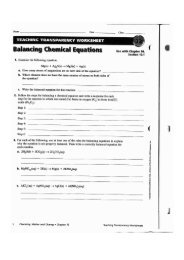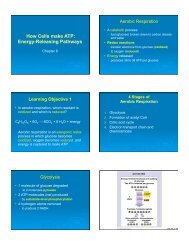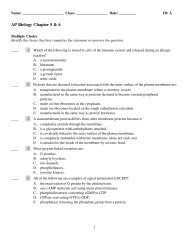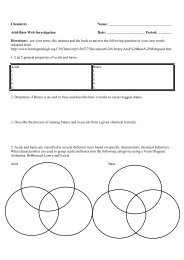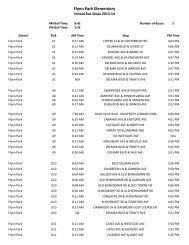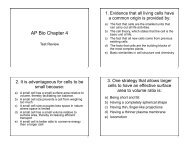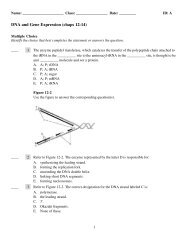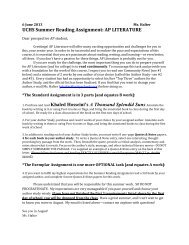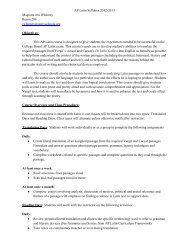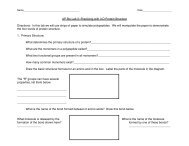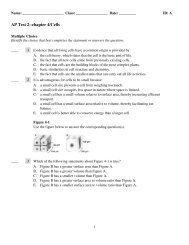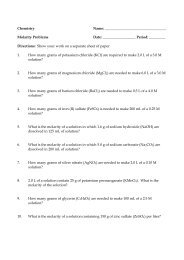Using BLAST and ExPASy for Genetic and Protein analysis of H1N1 ...
Using BLAST and ExPASy for Genetic and Protein analysis of H1N1 ...
Using BLAST and ExPASy for Genetic and Protein analysis of H1N1 ...
Create successful ePaper yourself
Turn your PDF publications into a flip-book with our unique Google optimized e-Paper software.
<strong>Using</strong> <strong>BLAST</strong> <strong>and</strong> <strong>ExPASy</strong> <strong>for</strong> <strong>Genetic</strong> <strong>and</strong> <strong>Protein</strong> <strong>analysis</strong> <strong>of</strong> <strong>H1N1</strong><br />
variability, including mutations that confer resistance to antiviral<br />
medications.<br />
Objectives:<br />
•Students will become familiar with the online databases available to researchers<br />
including GenBank, <strong>BLAST</strong> <strong>and</strong> ESPy utilities.<br />
•Students will analyze normal <strong>and</strong> mutant strains <strong>of</strong> <strong>H1N1</strong> viruses to look <strong>for</strong> nucleotide<br />
mutations that confer resistance to two antiviral therapies: zanamivir <strong>and</strong> oseltamivir.<br />
•Students will observe the effect <strong>of</strong> nucleotide changes on viral protein structure<br />
•Students will hypothesize if a previously unknown, but sequenced resistant strain has a<br />
similar resistance mutation or a new type<br />
•Students will research the glycoprotein upon which the anti-viral therapies act,<br />
neuraminidase, to investigate the reason <strong>for</strong> antiviral resistance due to the known<br />
mutations<br />
Previous Knowledge:<br />
1. In all cells <strong>and</strong> viruses, DNA is made <strong>of</strong> nucleotides <strong>and</strong> triplets <strong>of</strong> As, Ts, Cs <strong>and</strong> Gs<br />
code <strong>for</strong> specific amino acids<br />
2. <strong>Protein</strong>s are chains <strong>of</strong> amino acids<br />
3. The amino acid composition <strong>of</strong> the protein determines the shape, <strong>and</strong> there<strong>for</strong>e<br />
function <strong>of</strong> the protein, <strong>and</strong> changing the amino acids can change the shape <strong>and</strong><br />
function <strong>of</strong> the protein<br />
4. <strong>Protein</strong>s are essential components <strong>of</strong> all cells <strong>and</strong> viruses<br />
5. Viruses are intracellular parasites <strong>and</strong> have molecules on their surface, that among<br />
other things, allow the viruses to infect cells, replicate themselves <strong>and</strong> leave cells<br />
thereby destroying them<br />
Introduction: Influenza is an infection <strong>of</strong> the upper respiratory tract which causes<br />
sickness <strong>and</strong> death <strong>and</strong> widespread outbreaks also cause a significant economic impact<br />
as well. The <strong>H1N1</strong> influenza A p<strong>and</strong>emic <strong>of</strong> 2009 caused millions <strong>of</strong> people to become<br />
sick, hundreds <strong>of</strong> thous<strong>and</strong>s to be hospitalized <strong>and</strong> thous<strong>and</strong>s <strong>of</strong> deaths in the United<br />
States alone 1 . The new flu strain contained genes from influenza viruses from avian<br />
(bird), swine (pig) <strong>and</strong> human. New strains <strong>of</strong>ten cause more infection because our<br />
immune systems have been conditioned to respond to previously encountered strains.<br />
When strains mutate it allows them to more easily slip by our bodyʼs defenses. In<br />
addition, mutation can make previous vaccines <strong>and</strong> antiviral medications ineffective<br />
against them.<br />
1 http://www.cdc.gov/h1n1flu/estimates_2009_h1n1.htm Numbers are <strong>for</strong> United States only; worldwide<br />
projections are not given.
Background: Most <strong>of</strong> us are familiar now with the nomenclature “<strong>H1N1</strong>” but few <strong>of</strong> us<br />
know the meaning <strong>of</strong> these letters <strong>and</strong> numbers. Scientists label flu viruses based on<br />
the presence <strong>of</strong> two antigens on their surface. The first letter, “H” refers to the type <strong>of</strong><br />
Hemagglutinin present on the virusʼ surface. This molecule is primarily responsible <strong>for</strong><br />
the virusʼ ability to infect cells. The second letter, “N”, refers to the the type <strong>of</strong><br />
Neuraminidase present. This molecule helps the replicated virus leave from the cell in<br />
which is has replicated, allowing the many copies to infect more cells. These two<br />
proteins together determine much about the virus, including, in general, which species<br />
the virus can infect <strong>and</strong> the virulence <strong>of</strong> the particular strain. Even though there are<br />
many different strains <strong>of</strong> flu virus, they infect mammals <strong>and</strong> birds <strong>and</strong> there remains a lot<br />
<strong>of</strong> similarity between them. These similarities can be exploited to develop vaccines <strong>and</strong>/<br />
or anti-viral drug therapies that could be used against a wide array <strong>of</strong> similar viruses.<br />
Between 1999 <strong>and</strong> 2002 two new antiviral drugs were introduced into the population:<br />
zanamivir <strong>and</strong> oseltamivir. These same drugs were used to treat patients with <strong>H1N1</strong>. In<br />
just about 10 years it is possible <strong>for</strong> flu viruses to evolve resistance to these drugs. In<br />
order to monitor the potential development <strong>of</strong> resistant strains the Neuraminidase<br />
Inhibitor Susceptibility Network was established.<br />
Directions: You are a member <strong>of</strong> the Neuraminidase Inhibitor Susceptibility Network<br />
<strong>and</strong> the World Health Organization has contacted you with in<strong>for</strong>mation about a new viral<br />
strain that might have resistance to the antiviral drugs zanamivir <strong>and</strong> oseltamivir<br />
(Tamiflu). In this case study you will:<br />
•Use <strong>BLAST</strong> to compare <strong>H1N1</strong> sequences to observe conserved <strong>and</strong> variable<br />
regions<br />
•Align nucleotide sequences <strong>of</strong> normal strains <strong>of</strong> <strong>H1N1</strong><br />
•Align multiple nucleotide <strong>and</strong> protein sequences to look <strong>for</strong> mutations.<br />
•Compare the newly identified strain <strong>and</strong> hypothesize its resistance based on its<br />
mutations<br />
Part A: Introduction to <strong>BLAST</strong>n. Listed below are the identifying numbers <strong>for</strong> several<br />
“normal” (non-resistant) strains <strong>of</strong> <strong>H1N1</strong> that were sequenced during the 2009<br />
p<strong>and</strong>emic. In part A <strong>of</strong> this activity you will use online database tools to look at virus<br />
variation that does not confer antiviral resistance.<br />
Step 1: Go to the National Center <strong>for</strong> Biotechnology In<strong>for</strong>mationʼs website at: http://<br />
www.ncbi.nlm.nih.gov. From the menu at the top right, click on <strong>BLAST</strong>. <strong>BLAST</strong> st<strong>and</strong>s<br />
<strong>for</strong> “Basic Local Alignment Search Tool” <strong>and</strong> it is one <strong>of</strong> the many web-based<br />
applications available to investigate, analyze, research <strong>and</strong> identify genes <strong>and</strong> proteins<br />
<strong>of</strong> interest. The applications <strong>of</strong> <strong>BLAST</strong> <strong>and</strong> other tools are almost limitless! All <strong>of</strong> these<br />
things are free <strong>and</strong> open to the public. This particular site is maintained by the National<br />
Institutes <strong>of</strong> Health (NIH).<br />
Step 2: Choose nucleotide blast from the menu <strong>of</strong> choices under the heading “Basic<br />
<strong>BLAST</strong>”. To become familiar with <strong>BLAST</strong> output we will compare the nucleotide
sequences <strong>of</strong> two strains <strong>of</strong> <strong>H1N1</strong>. Enter this accession number in the box, CY056295.<br />
Give your job the title, “align two non-resistant <strong>H1N1</strong> strains”.<br />
Step 3: Click on the box in front <strong>of</strong> “Align two or more sequences”. This will open a<br />
new box. Enter accession number CY062530 in this box.<br />
Step 4: At the bottom section called “Program Selection” select the choice “Highly<br />
similar sequences (megablast). Then click “show results in a new window” so we can<br />
refer back to our search criteria if needed.<br />
Step 5: Click the “<strong>BLAST</strong>” button. Your search will show up in a new window or tab<br />
<strong>and</strong> if you scroll down you can see the aligned nucleotides <strong>for</strong> the two neuraminidase<br />
genes in our two strains.<br />
Answer the questions <strong>for</strong> Part A once your report is finished.<br />
Part A Questions:<br />
1. What are the lengths <strong>of</strong> the two sequences used in this comparison<br />
Query: _________ nucleotides<br />
Subject: _________ nucleotides<br />
2. How many differences can be found between the two str<strong>and</strong>s (count them!)<br />
_________ nucleotides<br />
3. Since every 3 bases codes <strong>for</strong> 1 amino acid, what is the maximum number <strong>of</strong> amino<br />
acids in the protein that would be made from the shorter <strong>of</strong> the two sequences<br />
_________ amino acids<br />
4. Will every nucleotide difference result in an amino acid difference Explain your<br />
answer.<br />
5. Since neither <strong>of</strong> these strains is resistant to anti-viral therapies, what can be<br />
concluded about the variation in the gene <strong>for</strong> neuraminidase between these two strains
Part B: Collecting Info on your sequences. There are a lot <strong>of</strong> details recorded about<br />
the sequences that are uploaded to the GenBank database. In Part B <strong>of</strong> this activity we<br />
will collect in<strong>for</strong>mation about our strains, including a reference number to their translated<br />
amino acid (protein) sequence. We will use these sequences in Pact C <strong>of</strong> this activity.<br />
Step 1: From the results <strong>of</strong> your <strong>BLAST</strong> page click on the link after “Query ID”. This<br />
will bring up all <strong>of</strong> the in<strong>for</strong>mation about this sequenced gene. Look over the in<strong>for</strong>mation<br />
<strong>and</strong> answer the questions:<br />
Part B Questions:<br />
1. When was this sample collected<br />
2. Who was the host <strong>of</strong> this virus Be as specific as possible<br />
3. From what country was this host<br />
4. If you scroll down to the bottom you can find the entire sequence <strong>and</strong> translated<br />
amino acid sequence. See appendix A or http://www.bio.davidson.edu/courses/<br />
genomics/jmol/aatable.html <strong>for</strong> a list <strong>of</strong> amino acid abbreviations. Write down the<br />
protein_id number:___________________<br />
Step 2: Use your back button to return to your <strong>BLAST</strong> results. Scroll down <strong>and</strong> click on<br />
the accession number <strong>of</strong> our subject sequence, cy062530.1. Answer the same 4<br />
questions about this viral strain.<br />
1. When was this sample collected<br />
2. Who was the host <strong>of</strong> this virus Be as specific as possible<br />
3. From what country was this host<br />
4. If you scroll down to the bottom you can find the entire sequence <strong>and</strong> translated<br />
amino acid sequence. See appendix A or http://www.bio.davidson.edu/courses/<br />
genomics/jmol/aatable.html <strong>for</strong> a list <strong>of</strong> amino acid abbreviations. Write down the<br />
protein_id number:___________________
Part C: <strong>Using</strong> <strong>BLAST</strong>p. In Part C <strong>of</strong> this activity we will use <strong>BLAST</strong>p to align two<br />
protein sequences.<br />
Step 1: Navigate back to the <strong>BLAST</strong> input page. From the tabs at the top click on<br />
“blastp”. If somehow you closed this window go back to http://www.ncbi.nlm.nih.gov.<br />
From here choose “blast” <strong>and</strong> then “protein blast”.<br />
Step 2: Input the first <strong>of</strong> the two protein sequences from Part B into the box. Click on<br />
“align two or more sequences” <strong>and</strong> enter the second protein reference number.<br />
Step 3: Choose “show results in a new window” <strong>and</strong> click the <strong>BLAST</strong> button.<br />
Step 4: Scroll down to the bottom to see the two sequences aligned. It is difficult to<br />
look <strong>for</strong> amino acid differences in this view. To change the view to make it easier, scroll<br />
to the very top. Click “Formatting options”. In the “alignment view” pull down menu,<br />
choose “query-anchored with dots <strong>for</strong> identitites”. Click the blue “re<strong>for</strong>mat” button to see<br />
the changed view.<br />
Step 5: Scroll back all the way to the bottom. Now you can see the identical amino<br />
acids marked with a dot, <strong>and</strong> the differences are marked with their respective amino<br />
acid letters.<br />
Answer the questions <strong>for</strong> Part C once your report is finished.<br />
Part C Questions:<br />
1. How many amino acid differences are there between the two sequences________<br />
2. List the differences here. Scientists use the numbers <strong>of</strong> the amino acids to label<br />
them. Record the differences here:<br />
Position 273:Query ______ Position 452: Query ______<br />
Subject ______ Subject ______<br />
3. Use Appendix A or http://www.bio.davidson.edu/courses/genomics/jmol/aatable.html<br />
to record what change in the type <strong>of</strong> amino acids has occurred at each site. Note your<br />
conclusions below:<br />
Site 273: Site 452:<br />
4. Even though we know these strains do not cause anti-viral resistance, which<br />
variation is more likely to confer resistance why<br />
5. What then can be concluded about this variation
Part D: Aligning multiple protein sequences. In Part D <strong>of</strong> this activity we will align<br />
multiple neuraminidase protein sequences to find the nature <strong>of</strong> the mutation that confers<br />
resistance to the two antiviral drugs, zanamivir <strong>and</strong> oseltamivir.<br />
Step 1: Navigate back to the blastp tool (see part C). Keep the query sequence the<br />
same as in Part C (ADD52538.1). Now click align two or more sequences <strong>and</strong> enter all<br />
<strong>of</strong> the following numbers, each followed by the enter/return key. Be sure to keep them<br />
in order so we will know which ones are resistant.<br />
4 normal strains:<br />
ADG27998<br />
ADB98137<br />
ACT67242<br />
BAJ05804<br />
<strong>and</strong> 4 mutant strains:<br />
ADB98138<br />
ADF97837<br />
ACT10319<br />
ADG28013<br />
Step 2: Choose “Show results in a new window” <strong>and</strong> click the <strong>BLAST</strong> button.<br />
Step 3: The default view <strong>for</strong> the results will show EACH sequence compared to the<br />
query sequence. We want to see them all together. At the top, change the <strong>for</strong>matting<br />
options to “query anchored with dots <strong>for</strong> identities”. Donʼt <strong>for</strong>get to click the “Re<strong>for</strong>mat”<br />
button <strong>for</strong> your changes to take effect. Then scroll down to view all <strong>of</strong> your amino acid<br />
sequences aligned. Imagine doing this <strong>analysis</strong> without a computer!<br />
Part D Questions:<br />
1. What conclusions can you draw from the in<strong>for</strong>mation. Be as specific <strong>and</strong> complete in<br />
your explanation as possible.
Part E: Analyzing a new mutant strain. You have been asked to analyze a new<br />
resistant strain <strong>of</strong> <strong>H1N1</strong>. You have been provided with the nucleotide sequence. In Part<br />
D <strong>of</strong> this activity you will translate the nucleotide sequence into an amino acid sequence<br />
to draw conclusions about the nature <strong>of</strong> its mutation.<br />
Step 1: Navigate to http://expasy.org/tools/<br />
There are many tools available to researchers at this site maintained by the SIB (Swiss<br />
Institute <strong>of</strong> Bioin<strong>for</strong>matics. Scroll to the bottom <strong>and</strong> choose translate. It can be found in<br />
section labeled DNA-->protein.<br />
Step 2: Copy <strong>and</strong> paste the sequence from appendix B into the box.<br />
Step 3: Click on translate sequence. This will translate the nucleotide sequence in all<br />
<strong>of</strong> the possible “frames”, 3 from the top str<strong>and</strong> <strong>and</strong> 3 from the bottom str<strong>and</strong>.<br />
Step 4: Examine the translated sequences. Your protein will not have many stop<br />
codons in the middle <strong>of</strong> the sequence <strong>and</strong> it should start with a “Met” <strong>for</strong> Methionine.<br />
Once you have located the most likely reading frame, click on this frame number.<br />
Step 5: You will see a new window with your sequence. Copy this protein sequence<br />
starting with the earliest M <strong>and</strong> ending with the last letter be<strong>for</strong>e the STOP codon.<br />
Step 6: Return to the <strong>BLAST</strong>p search page from Part D. Paste this new protein<br />
sequence into the second box. Be sure it is separate from the last entry by a enter/<br />
return.<br />
Step 7: Choose results in a new window <strong>and</strong> click <strong>BLAST</strong>.<br />
Step 8: Re<strong>for</strong>mat the results like you did in Part D to view all <strong>of</strong> the sequences aligned<br />
together. Donʼt <strong>for</strong>get to click the re<strong>for</strong>mat button.<br />
Part E Questions:<br />
1. What conclusions can you draw from the aligned sequences on the original nonmutant,<br />
mutant <strong>and</strong> new mutant strains Be as specific as possible in your <strong>analysis</strong>.<br />
Be sure to include where researchers should focus their study in the future to further<br />
analyze the nature <strong>of</strong> this new mutant strain.
EXTENSION--Part F: The anti-viral drugs zanamivir <strong>and</strong> oseltamivir target the active<br />
site <strong>of</strong> the catalytic component <strong>of</strong> neuraminidase. This active site has several key<br />
amino acids that function in the chemical reaction. In Part F <strong>of</strong> this activity you will<br />
research the new mutations amino acid substitutions to draw conclusions about which<br />
mutation is the likely cause <strong>of</strong> the antiviral resistance.<br />
Step 1: Use google to search <strong>for</strong> “PMCID: PMC1563878”. Click on the first result. This<br />
will bring up the Journal <strong>of</strong> Virology article, “Importance <strong>of</strong> Neuraminidase Active-Site<br />
Residues to the Neuraminidase Inhibitor Resistance <strong>of</strong> Influenza Viruses”.<br />
Step 2: Scroll down about half-way looking <strong>for</strong> figure 1. Click to enlarge this figure.<br />
This image shows the active site <strong>of</strong> neuraminidase <strong>and</strong> its interactions with its substrate,<br />
sialic acid (yellow). Antiviral drugs, such as Tamiflu act by mimicking the structure <strong>of</strong><br />
sialic acid <strong>and</strong> blocking this active site.<br />
Part F Questions:<br />
1. List below the neuraminidase amino acids that seem to play important roles in<br />
binding <strong>of</strong> sialic acid:<br />
_____________ _____________ _____________ ____________<br />
_____________ _____________ _____________ _____________<br />
_____________ _____________ _____________ _____________<br />
2. Which, if any, <strong>of</strong> these amino acids are mutated in our new strain<br />
3. How should researchers use this new in<strong>for</strong>mation
References:<br />
1. Campbell , A. Malcolm . "Amino Acids: Their Properties <strong>and</strong> Structures". Davidson<br />
College. 5/25/2010 .<br />
2. Decker, PhD, Janet M. "Case 3: The Case <strong>of</strong> the Variable Virus." Department <strong>of</strong><br />
Veterinary Science <strong>and</strong> Microbiology. University Of Arizona, n.d. Web. 5/20/2010.<br />
.<br />
3. "<strong>ExPASy</strong> Proteomics Server". Swiss Institute <strong>of</strong> Bioin<strong>for</strong>matics (SIB). 5/24/2010<br />
.<br />
4. "GenBank sequences from p<strong>and</strong>emic (<strong>H1N1</strong>) 2009 viruses". NCBI. 5/20/10 .<br />
5. "Influenza". Wikipedia. 5/20/10 .<br />
6. McKimm-Breschkin, J., T. Trivedi, A. Hampson, A. Hay, A. Kilmov, M. Tashiro, F.<br />
Hayden, <strong>and</strong> M. Zambon. "Neuraminidase Sequence Analysis <strong>and</strong> Susceptibilities <strong>of</strong><br />
Influenza Virus Clinical Isolates to Zanamivir <strong>and</strong> Oseltamivir." Antimicrobial Agents <strong>and</strong><br />
Chemotherapy 47(7).July (2003): 2264–2272. Web. 5/20/2010. .<br />
7. "National Center For Biotechnology In<strong>for</strong>mation". NCBI. 5/20/10 .<br />
8. "Neuraminidase". Wikipedia. 5/20/10 .<br />
9. "Updated CDC Estimates <strong>of</strong> 2009 <strong>H1N1</strong> Influenza Cases, Hospitalizations <strong>and</strong><br />
Deaths in the United States, April 2009 – April 10, 2010". Centers For Disease Control<br />
<strong>and</strong> Prevention. 5/24/2010 <br />
10. "Viral neuraminidase". Wikipedia. 5/20/10 .<br />
11. Yen, Hui-Ling, Erich H<strong>of</strong>fman, Garry Taylor, Christoph Scholtissek, Arnold S. Monto,<br />
Robert G. Webster, <strong>and</strong> Elena A. Govorkova. "Importance <strong>of</strong> Neuraminidase Active-Site<br />
Residues to the Neuraminidase Inhibitor Resistance <strong>of</strong> Influenza Viruses." American<br />
Society <strong>for</strong> Microbiology 80(17).September (2006): 8787–8795. Web. 5/20/2010. .
Appendix A<br />
Amino Acids: Their Properties <strong>and</strong> Structures<br />
Nonpolar (hydrophobic)<br />
amino acid three letter code single letter code<br />
glycine Gly G<br />
alanine Ala A<br />
valine Val V<br />
leucine Leu L<br />
isoleucine Ile I<br />
methionine Met M<br />
phenylalanine Phe F<br />
tryptophan Trp W<br />
proline Pro P<br />
Polar (hydrophilic)<br />
serine Ser S<br />
threonine Thr T<br />
cysteine Cys C<br />
tyrosine Tyr Y<br />
asparagine Asn N<br />
glutamine Gln Q<br />
Electrically Charged (negative <strong>and</strong> hydrophilic)<br />
aspartic acid Asp D<br />
glutamic acid Glu E<br />
Electrically Charged (positive <strong>and</strong> hydrophilic)<br />
lysine Lys K<br />
arginine Arg R<br />
histidine His H
Appendix B<br />
>gi|NewResistant<strong>H1N1</strong>|2010|<br />
agtttaaaat gaatccaaac caaaagataa taaccattgg ttcggtctgt atgacaattg<br />
gaatggctaa cttaatatta caaattggaa acataatctc aatatggatt agccactcaa<br />
ttcaacttgg gaatcaaaat cagattgaaa catgcaatca aagcgtcatt acttatgaaa<br />
acaacacttg ggtaaatcag acatatgtta acatcagcaa caccaacttt gctgctggac<br />
agtcagtggt ttccgtgaaa ttagcgggca attcctctct ctgccctgtt agtggatggg<br />
ctatatacag taaagacaac agtataagaa tcggttccaa gggggatgtg tttgtcataa<br />
ggggaccatt catatcatgt tcccccttgg aatgcagaac cttcttctcg actcaagggg<br />
ccttgctaaa tgacaaacat tccaatggaa ccattaaagt taggagccca tatcgaaccc<br />
taatgagctg tcctattggt gaagttccct ctccatacaa ctcaagattt gagtcagtcg<br />
cttggtcagc aagtgcttgt catgatggca tcaattggct aacaattgga atttctggcc<br />
cagacaatgg ggcagtggct gtgttaaagt acaacggcat aataacagac actatcaaga<br />
gttggagaaa caatatattg agaacacaag agtctgaatg tgcatgtgta aatggttctt<br />
gctttactgt aatgaccgat ggaccaagtg atggacaggc ctcatacaag atcttcagaa<br />
tagaaaaggg aaagatagtc aaatcagtcg aaatgaatgc ccctaattat cactatgagg<br />
aatgctcctg ttatcctgat tctagtgaaa tcacatgtgt gtgcagggat aactggcatg<br />
gctcgaatcg accgtgggtg tctttcaatc agaatctgga atatcagata ggatacatat<br />
gcagtgggat tttcggagac aatccacgcc ctaatgataa gacaggcagt tgtggtccag<br />
tatcgtctaa tggagcaaat ggagtaaaag gattttcatt caaatacggc aatggtgttt<br />
ggatagggag aactaaaagc attagttcaa gaaacggttt tgagatgatt tgggatccga<br />
acggatggac tgggacagac aataacttct caataaagca agatatcgta ggaataaatg<br />
agtggtcagg atatagcggg agttttgtyc agcatccaga actaacaggg ctggattgta<br />
taagaccttg cttctgggtt gaactaatca gagggcgacc caaagagaac acaatctgga<br />
ctagcgggag cagcatatcc ttttgcggtg taaacagtga cactgtgggt tggtcttggc<br />
cagacggtgc tgagttgcca tttaccattg acaagtaatt tgttcaaaaa act



